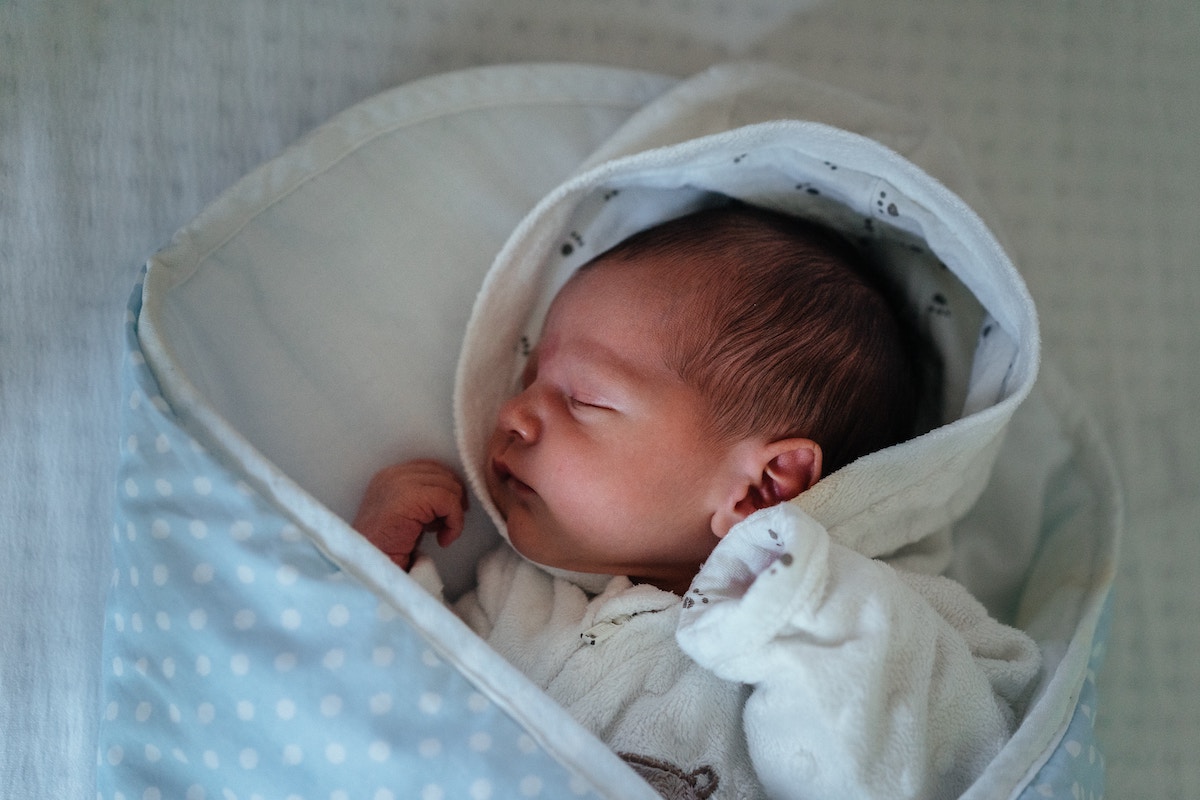If you’re feeling overwhelmed or frustrated with your newborn’s sleep patterns, don’t worry – you have come to the right place! Newborn sleep training is just plain hard! This article is all about helping you, as a new parent, get your baby to sleep through the night.
Getting your newborn baby to sleep through the night is, without a doubt, one of the major goals of new parents. It can be a very daunting task, especially if you are not sure how to go about it. That’s where sleep training comes in.
Newborn sleep training is a way to teach your baby healthy sleep habits, allowing them to get the rest they need without relying on parents for help. Newborn sleep training can involve various methods, such as setting consistent nap and bedtimes, establishing a regular bedtime routine, or engaging in modified cry it out method. It can also include providing reassurance and support during sleep times, or working with baby on calming techniques like swaddling and soothing.
Read more: 26 Best New Baby Gifts That Every Parent Will Love
Sleep training is important for both the baby and the parents as it can help improve the quality of sleep for the baby and provide parents with a more consistent sleep schedule. The sleep training process helps babies learn the skills they need to eventually self-soothe, which can be an invaluable tool for them as they grow and develop.
Newborn sleep training can also help reduce the stress associated with trying to find the right balance between responding to a baby’s needs and allowing them to learn to fall asleep independently. Plus, it can help parents gain more insight into their baby’s sleep needs, which can enable parents to better understand how to balance the need for sleep with the need for parental attention.

Understanding Newborn Sleep
Newborns tend to sleep in short bursts – anywhere from 16-17 hours a day – but generally have periods of wakefulness that last for 1-2 hours. During the first few weeks, babies may sleep as much as 18-19 hours a day, with most of their sleep occurring in the first half of the day. By 4-6 weeks, most newborns have a more consistent sleep/wake cycle that includes 4-5 longer periods of sleep throughout the day, interspersed with shorter awakened periods.
Newborn sleep training is tricky, and definitely not for the faint of heart. Many newborns can be unpredictable with their sleeping patterns, and getting them into a consistent routine can be difficult. Plus, newborns can easily become overtired, which leads to difficulty sleeping or staying asleep.
Sometimes when babies are separated from their parents or caregivers, they may find it hard to settle in and go to sleep. This only makes tackling newborn sleep training even more difficult to handle. Sudden noises, lights, as well as feeding issues only contribute to the ongoing struggle of helping a baby develop healthy sleep habits.
Different Approaches to Newborn Sleep Training
Cry it out method
The Cry It Out method is a popular sleep training technique that helps parents teach their babies how to self-soothe and fall asleep independently. This method works best for babies who are at least 6 months old and generally involves leaving your baby to cry in the crib until they drop off to sleep on their own. Parents may also stay in the room if they choose, but they should remain quiet and avoid making eye contact or physically interacting with their baby in any way. The goal is for both the parent and child to learn to relax and not rely on each other for emotional reassurance during bedtime.
No cry method
The no cry method is an approach to child discipline and parenting that focuses on understanding the child’s needs and responding with empathy rather than punishment. This method encourages parents to use verbal guidance and positive reinforcement to shape their child’s behavior, rather than punishments or threats. The idea behind the no cry method is that it helps create a more positive relationship between the parent and child while still providing effective discipline.
Ferber method
The Ferber method, also known as “controlled comforting,” is a sleep training approach that involves gradually increasing the amount of time between parental responses to a baby’s nighttime crying. It is sometimes referred to as “progressive waiting.”
The technique is based on the idea that babies learn to sleep better when they are allowed to cry for progressively longer periods of time during their bedtime routine, as it helps them learn to soothe themselves back to sleep. Parents establish a routine in which they will wait an increasing amount of time before responding to their baby’s cries whenever they wake up in the night. This means that if the baby wakes up in the middle of the night and starts to cry, the parent will wait a certain amount of time before responding. This amount of time will increase with each cycle until the baby learns to self-soothe and go back to sleep.
It is important to note that this technique should never be used with a new baby who is under 6 months old. During this time, it is more important for parents to make sure their baby is receiving enough food and comfort, rather than trying to train them to sleep at night. Furthermore, the Ferber method requires consistency and patience, and should not be used if a parent is unable to respond to their child’s cries in a calm, caring manner.
Baby-led sleep
Baby-led sleep is a newborn sleep training approach to helping babies and young children get the sleep they need without the intervention of parents. It involves creating an environment that is conducive to sleep by setting up clear expectations and rules around sleep, such as when it’s time to go to bed, how long naps should be, and what happens when a baby wakes up during the night. Baby-led sleep also focuses on teaching babies how to self-soothe by providing them with comforting activities and objects, including a lovey, sleep sack, a white noise machine, or music. Parents can also use positive reinforcement and rewards to help their babies learn the skills of sleeping independently.

Tips for Successful Newborn Sleep Training
Newborn sleep training is essentially a process of teaching babies and toddlers how to sleep through the night, and how to stay asleep for longer periods of time. This process helps to establish regular sleep patterns so that babies and toddlers are getting the appropriate amount of sleep they need each night. Some of the most basic steps of an effective sleep training plan include:
- Establish a consistent bedtime routine: A consistent routine helps to cue the body that it is time for sleep. This can involve giving the child a bath, reading a book, or talking about the day.
- Put the baby to bed drowsy, but awake: Putting the baby down when they are still a bit awake helps them connect the routine with the bedtime, and also helps them learn to fall asleep on their own.
- Make sure the baby’s room is dark and quiet: An environment that is conducive to sleep is essential. This means minimizing noise and creating a calm atmosphere.
- Remain consistent: Patience and consistency are very important when it comes to newborn sleep training. Don’t take our word for it; award-winning sleep expert Suzy Giordano (otherwise known as “The Baby Coach”) created one of the most popular sleep-training books on the market for parents striving to help their baby sleep independently. Suzy’s newborn sleep training method, initially developed for newborn multiples, has been successfully adapted to work with singletons, older babies, and even their parents. Through regular feeding times and 12 hours of sleep at night, Suzy’s method offers parents peace of mind, less strain on their marriage, and a happier, more well-rested baby.
- Avoiding over-stimulation: Turn off screens and other devices an hour before bedtime and make sure the room is dark and free of noise.
- Feeding the baby appropriately: When sleep training a baby, it’s important to make sure that the baby is fed appropriately. This means that when the baby wakes up at night, they should be offered a full, nutritious meal to prevent hunger from keeping them awake. The best way to feed a baby for sleep training is to offer them a breast or bottle-feeding of expressed breast milk or formula, whichever method of feeding the baby is more comfortable for them. It’s important to ensure that the baby has had enough calories during the day to make up for night feedings, as this will help them stay asleep for longer periods of time.
Additional Strategies for Helping Your Newborn Sleep Training Journey
Swaddling
Swaddling is an age-old practice that can help babies sleep better and feel secure. It involves wrapping the baby snugly in a blanket or cloth to resemble the warm, tight spaces they experienced in the womb. It helps to provide comfort and security to the baby, and ensures that they stay in one position while they sleep. Swaddling should be done correctly to ensure safety, as babies can easily slip their arms out of the blanket if it is not secured properly. It is not recommended to use swaddling past 2-3 months old, as at this point most babies can start to roll over, at which point swaddling can become a suffocation risk.
Using white noise
White noise is a type of sound known to help soothe and relax babies, making it an effective sleep aid for infants. It can also block out other household noises and distractions, helping to create a calm and restful environment for babies. Studies have shown that white noise can reduce the amount of time it takes for babies to fall asleep, as well as increasing their overall sleep quality. Many parents have found success in using white noise to help their babies sleep more soundly.
Using a pacifier
Using a pacifier to help baby sleep can be an effective way to help soothe and calm a fussy infant. Pacifiers can help reduce fussiness and create a sense of security and comfort for babies. They can also help prevent sudden infant death syndrome (SIDS) by keeping the baby’s airway open during sleep.
However, it is important that parents monitor the use of pacifiers and follow the recommended guidelines. Excessive use of pacifiers can lead to problems with dental development, speech impediments and ear infections. Therefore, parents should limit pacifier use when the baby is sleeping, and avoid using it to replace meals or as a reward.
Practicing skin-to-skin contact
Skin-to-skin contact, or kangaroo care, is a practice that has been proven to help babies sleep better. This involves placing a baby, wearing only a diaper, on their parent’s bare chest for extended periods of time. This helps to provide the baby with physical, emotional and physiological benefits such as stabilizing their heart rate and breathing, helping to regulate temperature, reducing stress, and increasing oxytocin production. It also helps to bond the parent and child which can have long-lasting effects on the baby’s emotional health.
Troubleshooting Common Problems with Newborn Sleep
Sleep regression
Sleep regression is a normal development stage when babies or toddlers suddenly begin to wake up frequently throughout the night and have difficulty going back to sleep. It typically occurs as babies transition from one stage of development to the next, such as during the 4-month sleep regression or the 8-month sleep regression. While generally temporary, it can be frustrating for parents.
During sleep regression, babies may wake up more often, sleep for shorter periods, become more active during the night, or resist sleep altogether. Most sleep regressions last for an average of two to four weeks, but they can last longer in some cases.
Parents can help their baby adjust to sleep regression by creating a consistent bedtime routine, providing a dark and quiet environment, and avoiding stimulating activities just before bedtime. They can also comfort their baby with a gentle pat or rub on the back, shushing, or a pacifier. If necessary, they can also give their baby a warm bath or feed them to try to settle them.
Reflux
Reflux in babies is a common condition that occurs when the stomach contents, including acid, flow back up into the esophagus. It can occur at any age but is most common in infants. Symptoms may include spitting up, crying while feeding, arching of the back, irritability, and vomiting. Treatment typically involves lifestyle changes, such as keeping the baby upright after feedings, thickening feeds with rice cereal or other thickeners, and avoiding foods that may increase reflux symptoms. In some cases, medications may be prescribed to reduce acid production or strengthen the sphincter muscle at the bottom of the esophagus.
Colic
Colic is a term used to describe excessive and frequent crying in babies. It is estimated that nearly 20% of all babies experience colic at some point. The exact cause of colic is unknown but is believed to be linked to an immature digestive system, food sensitivities, or an infant’s inability to self-soothe.
To help alleviate colic in babies, parents should keep their baby in a quiet and dark room to help them calm down, swaddle them to provide a secure feeling, provide a pacifier for sucking and distraction, and try different forms of gentle rocking and shushing. Diet modifications can also be beneficial, such as using hypoallergenic formula or eliminating dairy, wheat, and other allergenic foods from the mother’s diet if she is breastfeeding. Finally, it is important to seek professional help if colic persists.
The Benefits of Newborn Sleep Training
Successful newborn sleep training can have numerous benefits on the quality of life for both baby and parents. One benefit is that it can help the baby develop healthy sleep patterns, which will ensure they get enough rest to maintain proper physical and mental development. In addition, sleep training can help reduce the risk of Sudden Infant Death Syndrome (SIDS) by establishing safe sleep practices.
The improved sleep for baby can also help parents get more restful sleep as well, since they won’t be waking up as often in the middle of the night to tend to their child. Newborn sleep training can also drastically reduce stress levels for both baby and parents, since the parents don’t have to worry about constantly trying to figure out how to get their child to sleep. Plus, the improved sleep for both baby and parents can lead to an improved mood and energy level, which can make daily life much more enjoyable.
Don’t Stress It!
The topic of newborn sleep training is a complex and controversial one. While there are a variety of methods and approaches that parents may use to help their newborns sleep better, it is important to remember that all babies are unique and may respond differently to different techniques.
Some experts believe that sleep training should not be attempted until a baby is at least 4-6 months old and that until then, parents should focus on establishing good sleep habits and routines. Other experts argue that it is never too early to start gently encouraging healthy sleep habits, but emphasize the importance of doing so in a developmentally appropriate way that takes into account the needs of the individual child.
Ultimately, the decision about whether and how to sleep train a newborn is a personal one that should be based on a family’s unique needs and circumstances. It is important for parents to consult with their pediatrician and consider the advice of trusted experts in the field before making any decisions about sleep training their newborn.
WANT TO READ MORE?
Check out Preparing Your Only Child For a New Baby At Home for more newborn baby tips!
CONNECT WITH DAILY MOM
💖 NEWSLETTER: DAILY READS IN YOUR INBOX 💖
Sign up to receive our picks for the best things to do, see and buy so you can relax and focus on more important tasks! Let us help you be the best version of yourself you can be!
BE SOCIAL WITH US
📌 LOVE IT? PIN IT!📌












































